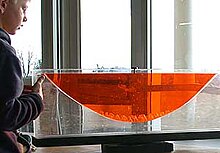
Liquid-mirror telescopes are telescopes with mirrors made with a reflective liquid. The most common liquid used is mercury, but other liquids will work as well (for example, low-melting point alloys of gallium). The liquid and its container are rotated at a constant speed around a vertical axis, which causes the surface of the liquid to assume a paraboloidal shape. This parabolic reflector can serve as the primary mirror of a reflecting telescope. The rotating liquid assumes the same surface shape regardless of the container's shape; to reduce the amount of liquid metal needed, and thus weight, a rotating mercury mirror uses a container that is as close to the necessary parabolic shape as feasible. Liquid mirrors can be a low-cost alternative to conventional large telescopes. Compared to a solid glass mirror that must be cast, ground, and polished, a rotating liquid-metal mirror is much less expensive to manufacture.
Isaac Newton noted that the free surface of a rotating liquid forms a circular paraboloid and can therefore be used as a telescope, but he could not build one because he had no way to stabilize the speed of rotation.[1] The concept was further developed by Ernesto Capocci (1798–1864) of the Naples Observatory (1850),[2][3] but it was not until 1872 that Henry Skey of Dunedin, New Zealand, constructed the first working laboratory liquid-mirror telescope.
Another difficulty is that a liquid-metal mirror can only be used in zenith telescopes, i.e., that look straight up, so it is not suitable for investigations where the telescope must remain pointing at the same location of inertial space (a possible exception to this rule may exist for a liquid-mirror space telescope, where the effect of Earth's gravity is replaced by artificial gravity, perhaps by propelling it gently forward with rockets). Only a telescope located at the North Pole or South Pole would offer a relatively static view of the sky, although the freezing point of mercury and the remoteness of the location would need to be considered. A radio telescope already exists at the South Pole, but the same is not the case with the North Pole as it is located in the Arctic Ocean.
The mercury mirror of the Large Zenith Telescope in Canada was the largest liquid-metal mirror ever built. It had a diameter of 6 meters and rotated at a rate of about 8.5 revolutions per minute. It was decommissioned in 2016.[4] This mirror was a test, built for $1 million, but it was not suitable for astronomy because of the test site's weather. As of 2006,[5] plans were being made to build a larger 8-meter liquid-mirror telescope ALPACA for astronomical use,[6] and a larger project called LAMA with 66 individual 6.15-meter telescopes with a total collecting power equal to a 55-meter telescope, resolving power of a 70-meter scope.[7][8]

- ^ "What is an LMT?".
- ^ Capocci (1850). "M. Quetelet lit extraits suivants d'une lettre de M. Capocci, astronome à Naples" [Mr. Quetelet reads the following extracts from a letter from Mr. Capocci, an astronomer at Naples]. Bulletins de l'Académie Royale des Sciences, des Lettres et des Beaux-arts de Belgique (in French). 17, pt. 2: 299–302. From p. 300: "Il agit d'obtenir, à peu de frais, de grands mirroirs parfaits, même paraboliques. […] de manière à rassembler parfaitement les rayons réfléchis en un point, … " (It is a matter of obtaining, at low cost, large perfect mirrors, even parabolic [ones]. I think that if a suitable rotational movement were given to a circular canister [that was] filled with mercury, and [if] this movement were well executed and uniform, it would end up by making the surface of the liquid so arranged as to perfectly collect the reflected rays into a point, … )
- ^ During the winter of 1850, the Dutch astronomer Friedrich Wilhelm Christian Krecke (1812 – 1882) performed Capocci's proposed experiment: he suspended a bowl of mercury by a twisted cord; as the cord unwound, the mercury adopted the shape of a paraboloid. The mirror produced impressive reflections of a gas chandelier. See: Krecke (1851). "M. Quetelet fait part d'une lettre qu'il a reçu de M. Krecke, …" [Mr. Quetelet published part of a letter that he received from Mr. Krecke, …]. Bulletins de l'Académie Royale des Sciences, des Lettres et des Beaux-arts de Belgique (in French). 18, pt. 1: 363–365.
- ^ Physics Footnotes: Liquid Mirror Telescopes.
- ^ Crotts, Arlin P.; ALPACA Consortium (2006-12-01). "ALPACA: An Inexpensive but Uniquely Powerful Imaging Survey Telescope". American Astronomical Society Meeting Abstracts. 209: 99.05. Bibcode:2006AAS...209.9905C.
- ^ ALPACA overview.
- ^ Hickson, Paul; Lanzetta, Kenneth M. (2004). "Large aperture mirror array (LAMA): Project overview". In Ardeberg, Arne L; Andersen, Torben (eds.). Second Backaskog Workshop on Extremely Large Telescopes. Vol. 5382. pp. 115–126. doi:10.1117/12.566118. hdl:2429/37487. S2CID 43104264.
- ^ The University of British-Columbia Liquid-Mirror Observatory - Perfecting the next generation of super telescopes.